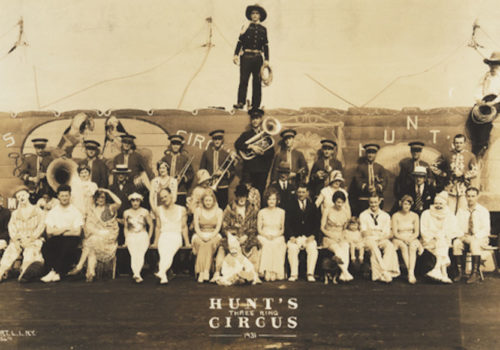Foule (crowds), one of the most surprising series at this year’s Rencontres d’Arles, is a compilation of photographs taken between the end of the19th century and the middle of the 20th. They’re the kind of photographs hardly anyone makes these days, and rarely in similar dimensions: photographs of groups of American men and women, extraordinary historical documents to be observed from close-up and afar. Their stories are revealed in the details, from the portraits of the Ku Klux Klan, armed groups of different eras, sports teams, circus troupes, tribes, schools, political assemblies, baptisms and burials.
These 225 photographs from unknown photographers and studios—a fascinating feature of this selection—the collector W.M. Hunt spent over 15 years piecing it together through eBay, specialized sales and from other collectors, mainly the antique dealer Mathias Roudine, a specialist in panoramic photographs from 1900 to 1950 whose shop is in the Saint-Ouen flea market on the outskirts of Paris. “It’s funny because these photographs have probably travelled like no other between the United States and Europe,” says W.M Hunt. “Who are these people and what brought them together? These are bizarre, enigmatic, visual matrices of information that we can attempt to decode many ways. I like when the blacks and whites play against each other in some sort of unique pattern, literally like a music staff with notes. Think of these as visual arpeggios. This is jazz.”
Like the collector says, these photographs can be viewed as abstract paintings. And despite their apparent simplicity, they were probably rather difficult to shoot: it takes considerable technique to capture the faces of these dozens, hundreds or thousands of men side-by-side. Seen this way, the photographs of military groups are exceptional, revealing much about the importance of symbolism when they were taken. One was photographed at Battle Creek, Michigan, in 1918, with 30,000 men forming a shield with the colors and patterns of the American flag. Another photograph, shot in San Antonio, Texas, in 1926, involved a similar number of people depicting another insignia, here reproduced in a very small format, in contrast with this grandiose operation. “They’re not expressionistic or conceptual. The impact they have can be surreal, but that’s in the mind of the looker not the maker.”
W.M. Hunt also has a fine sense of humor, and other photographs in his collection show a group of men dressed up like giant slices of bread, an entire basketball team whose members are covering their faces with both hands, and another of his family showing off theirs. “I have included a family photograph. The 1955 St. Clair River Dance Club haunted me for 50 years. I coveted this image but did not possess it. The original hung in a hotel hallway in my old hometown. Collectors are single-minded. They have to be nible and sometimes they feel they should travel with a small caliber handgun but certainly with a screwdriver. This image has a long story but here it is, as a copy print. Look closely though and you will find my father and mother in that funny crowd.Foule means ‘crowds’ in French but the fool references is intentional and meant ironically to describe the collector and his behavior. ” The only photograph missing from W.M. Hunt’s immense collection? “Coney Island Beach (1940) by Weegee. I don’t know if I will ever be able to find it in a good condition and buy it. And if I will, it will be very expensive!”
EXHIBITION
Foule: Hunt’s Three Ring Circus
July 7th – September 21st, 2014
Collection W.M. Hunt
Palais de l’Archeveché
35 Place de la République
13200 Arles
France
http://www.rencontres-arles.com/
http://www.wmhunt.com/
















